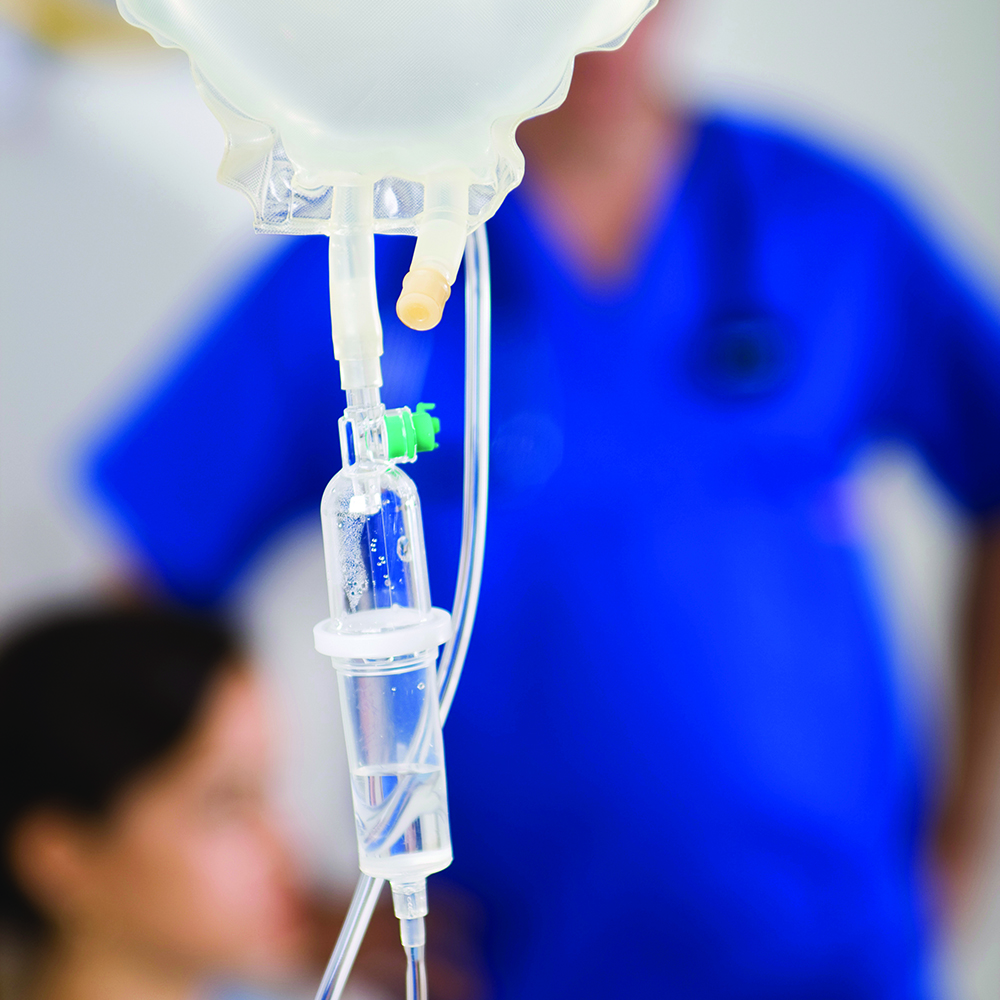

Trastuzumab deruxtecan has been added to the Pharmaceutical Benefits Scheme (PBS) for the treatment of metastatic human epidermal growth factor receptor 2 (HER2)–positive breast cancer. Around 15-20% of all breast cancers are HER2 positive, with this subtype traditionally associated with poorer patient outcomes.
Trastuzumab deruxtecan is an antibody-drug conjugate (ADC). The antibody portion selectively targets the extracellular domain of the HER2 protein, and deruxtecan is a topoisomerase inhibitor. Once the ADC binds to HER2 on the tumour cell, it is internalised and undergoes enzymatic cleavage. This causes the topoisomerase I inhibitor to be released, which leads to DNA damage and apoptosis. The cytotoxic portion of the ADC has high membrane permeability, allowing it to also act against neighbouring cells. This “bystander effect” is beneficial as not all cells in HER2-positive breast cancer overproduce HER2.
Trastuzumab deruxtecan is not interchangeable with trastuzumab (Herzuma®) or trastuzumab emtansine (Kadcyla®). The DESTINY-Breast03 trial compared the efficacy and safety of trastuzumab deruxtecan with trastuzumab emtansine in patients with HER2-positive metastatic breast cancer previously treated with trastuzumab and a taxane. In the trastuzumab deruxtecan group, 75.8% of patients were alive without disease progression at 12 months, compared to 34.1% in the trastuzumab emtansine group. The overall incidence of drug-related adverse effects was higher in the trastuzumab deruxtecan group (98.1% versus 86.6%). The incidence of interstitial lung disease was also higher in the trastuzumab deruxtecan group (10.5%) compared to the trastuzumab emtansine group (1.9%). Patients should be monitored for signs and symptoms of this condition and advised to immediately report cough, dyspnoea, fever, or new or worsening respiratory symptoms.


The Therapeutic Goods Administration (TGA) has published a safety alert regarding the use of high doses of baclofen. This alert has been issued following recent coronial inquiries into two deaths.
Baclofen is a skeletal muscle relaxant indicated for chronic spasticity of spinal or cerebral origin. The usual oral dose range for these patients is 30-75mg daily (given in three divided doses). However, baclofen is sometimes prescribed off-label for the management of alcohol-use disorder. There is no universally accepted dosing recommendation in this setting, and higher doses are often used.
Baclofen is a structural analogue of gamma-aminobutyric acid (GABA) and can cause significant depression of the central nervous system (CNS). The TGA advises health professionals to be aware of the risk of intentional and unintentional overdose in patients taking baclofen for alcohol-use disorder. Symptoms of overdose may include reduced consciousness, respiratory depression, hyporeflexia, convulsions, and cardiac arrhythmias. Deterioration is more likely if combined with other CNS depressants.


Azacitidine tablets are now available on the Pharmaceutical Benefits Scheme (PBS) for the treatment of acute myeloid leukaemia (AML) following intensive induction chemotherapy.
The safety and efficacy of azacitidine tablets in this setting was evaluated in the pivotal QUAZAR AML-001 trial. In this double-blind study, patients with AML in first remission were randomised to receive oral azacitidine or placebo. Oral azacitidine was associated with a significantly longer overall survival compared to placebo (24.7 months versus 14.8 months). This favourable effect was noted in patients with both measurable residual disease (MRD)-positive and MRD-negative status at baseline.
The usual recommended dose is 300mg orally once daily for 14 days, followed by a 14-day treatment-free period. During the first two treatment cycles, an antiemetic is given 30 minutes before each azacitidine dose. In the event of disease relapse (5-15% blasts in the peripheral blood or bone marrow), treatment may be extended to 21 days of each 28-day cycle. However, treatment should be discontinued if disease progression occurs (blasts exceed 15% in either the peripheral blood or bone marrow).
The availability of an oral formulation improves convenience for patients and avoids injection site reactions which are common with the injectable formulation. Azacitidine tablets cannot be used interchangeably with azacitidine injection as there are significant differences in exposure and the dosing schedule. The mean oral bioavailability of azacitidine tablets relative to subcutaneous administration is around 11%. However, there is high interpatient variability. Food has a minimal effect on exposure and azacitidine tablets may be administered either with or without food.


The Pharmaceutical Benefits Scheme (PBS) listing for enzalutamide has recently been expanded. Enzalutamide is an oral inhibitor of androgen receptor signalling. It is now subsidised for the treatment of metastatic hormone-sensitive prostate cancer, in addition to castration-resistant metastatic and non-metastatic prostate cancer.
The ARCHES trial investigated the safety and efficacy of enzalutamide in the treatment of metastatic hormone-sensitive prostate cancer. Patients were randomised to receive enzalutamide (160mg daily) or placebo, with both groups also receiving androgen deprivation therapy (ADT). Patients in the enzalutamide group had a 61% reduced risk of radiographic disease progression or death compared to the placebo group. The ENZAMET trial further supports the efficacy of enzalutamide in this patient group. In this trial, patients were randomised to receive ADT plus either enzalutamide or standard care with a nonsteroidal antiandrogen (e.g. bicalutamide, nilutamide, or flutamide). After a median follow-up of 68 months, the median overall survival was not reached. However, the five-year overall survival was significantly higher in the enzalutamide group (67% versus 57%).
The safety of enzalutamide in the ARCHES trial was consistent with the findings of earlier studies conducted in castration-resistant prostate cancer. Adverse effects of grade 3 or higher were slightly more common in the placebo group (25.6% versus 24.3%). The most common adverse effects reported in the active group included hot flushes, fatigue, and musculoskeletal events. No unexpected adverse events were reported.


The darolutamide product information has recently been updated to include information about hepatotoxicity.
Darolutamide is a non-steroidal androgen receptor antagonist used in the treatment of prostate cancer. In the ARAMIS trial involving 1508 men with nonmetastatic, castration-resistant prostate cancer, darolutamide was associated with some changes in liver enzymes. Elevated serum aspartate aminotransferase (AST) occurred more commonly in the darolutamide group compared to placebo (23% versus 14%); serum bilirubin was also more frequently raised in the darolutamide group (16% versus 7%). However, elevations in AST and bilirubin were typically mild to moderate. Increases in alanine aminotransferase (ALT) levels were uncommon.
Cases of idiosyncratic drug-induced liver injury (DILI) with increases in ALT or AST of ≥ grade 3, including cases accompanied with bilirubin two or more times the upper limit of normal, have been reported during therapy with darolutamide. The onset ranged from around one month up to a year after starting darolutamide and were reversible following discontinuation. The manufacturer recommends permanent discontinuation of darolutamide if liver function test results suggestive of idiosyncratic DILI occur.


Patiromer is now available on the Pharmaceutical Benefits Scheme (PBS) for the treatment of chronic hyperkalaemia. Criteria to qualify for PBS-subsidised treatment include:
- Stage 3-4 chronic kidney disease;
- Condition not adequately controlled by a low potassium diet;
- At least two episodes of hyperkalaemia (serum potassium ≥ 6.0 mmol/L) within the 12 months before initiating patiromer; and
- Patient must be receiving a renin-angiotensin-aldosterone system inhibitor (unless unable to tolerate).
Patiromer is a non-absorbable polymer that binds potassium in the lumen of the gastrointestinal tract. This increases the faecal excretion of potassium, thereby lowering serum levels. Patiromer is not recommended as the sole treatment of hyperkalaemia in patients with ECG changes, as the onset of effect is around four to seven hours.
Patiromer may bind some co-administered oral drugs, which could reduce their absorption. The product information lists medications that are not affected by this interaction. It is recommended that the administration of all other oral medications be separated from patiromer by at least three hours. As patiromer is not absorbed, drug interactions are expected to be confined to the gastrointestinal tract.
The incidence of adverse events was similar for patiromer and placebo groups in clinical trials. Caution is required in patients at risk of hypercalcaemia as patiromer contains calcium as part of the counterion complex, which is partially released. Magnesium levels should be monitored for at least one month after starting therapy as reductions in serum magnesium may occur.
Polystyrene sulfonate resins are another option to increase faecal potassium excretion. However, there is a lack of randomised data to support their use in the treatment of chronic hyperkalaemia, and they are also associated with serious gastrointestinal adverse effects. These factors, combined with the poor palatability of polystyrene sulfonate resins, may make patiromer a more attractive option in some cases.


The Therapeutic Goods Administration (TGA) has issued a safety advisory regarding an association between liver injury and medicines containing turmeric or curcumin. The TGA has received 18 reports of liver problems in people taking products containing turmeric or curcumin, including one fatality.
Following a safety investigation, the TGA concludes that the current evidence demonstrates a rare risk of liver injury from taking medicinal products containing curcumin. Factors that potentially increase the risk of liver injury include high curcumin doses, products with enhanced absorption, and pre-existing liver problems. As a precautionary measure, the TGA advises that curcumin-containing medicines should be avoided by people with a history of liver problems.
Evidence suggests that the incidence of liver injury related to herbal and dietary supplements is increasing in Australia. As complementary medicines are typically considered safe, patients may not always think it relevant to inform their healthcare professional that they are taking them. Utilising the principles of the best possible medication history ensures that these types of products are not missed when a patient presents to hospital.


Eptinezumab has been added to the Pharmaceutical Benefits Scheme (PBS) for the preventive treatment of chronic migraine in adults. To qualify for PBS subsidy, patients must average 15 or more headache days per month (with at least eight days of migraine) for at least six months before initiating treatment.
Eptinezumab is a calcitonin gene-related peptide (CGRP) antagonist. Elevated CGRP levels have been associated with migraine, with this neuropeptide implicated in pain modulation. The safety and efficacy of eptinezumab were evaluated in the PROMISE-2 trial. Adults with chronic migraine were randomly assigned to receive eptinezumab 100mg, eptinezumab 300mg, or placebo on day 0 and week 12. Patients in the eptinezumab group achieved a significant reduction in monthly migraine days compared to placebo, with benefits becoming apparent on the first day after initiation of therapy. These results were supported by the longer-term open-label PREVAIL trial. Favourable safety and efficacy profiles were maintained over the two-year trial period. However, this trial used a 300mg dose, which is not subsidised on the PBS.
Other CGRP antagonists available include galcanezumab, fremanezumab, and erenumab. Due to their large molecular size, all of these medicines must be administered parenterally. Galcanezumab and fremanezumab are also available on the PBS.


A new indication has been added to the product information for baricitinib. In addition to rheumatoid arthritis and atopic dermatitis, baricitinib is now also approved for the treatment of severe alopecia areata. This therapy may be considered for adult patients for whom other therapies are either ineffective or inappropriate.
Alopecia areata is a complex autoimmune condition that can cause hair loss of the scalp, eyebrows, and eyelashes. Many of the cytokines involved in the pathogenesis of this disorder depend upon Janus kinases (JAKs) for intracellular signalling. The BRAVE-AA trials investigated the safety and efficacy of baricitinib, a JAK inhibitor, for this condition.
Patients with a Severity of Alopecia Tool (SALT) score of at least 50 (where 0 = no scalp hair loss and 100 = complete scalp hair loss) were randomly assigned to receive baricitinib 2mg daily, baricitinib 4mg daily, or placebo. The primary outcome was a SALT score of 20 or less at week 36. In the BRAVE-AA2 trial, the primary outcome was reached in 35.9% of patients in the baricitinib 4mg group, 19.4% in the baricitinib 2mg group, and 3.3% in the placebo group.
Adverse effects more commonly reported in the baricitinib groups include acne, elevated creatine kinase levels, and increased low- and high-density lipoprotein cholesterol levels. Baricitinib is not currently subsidised on the Pharmaceutical Benefits Scheme (PBS) for treating alopecia areata.


The tablet presentation of acalabrutinib has recently been added to the Pharmaceutical Benefits Scheme (PBS). Acalabrutinib is also available in a capsule and is PBS-subsidised for the treatment of relapsed or refractory chronic lymphocytic leukaemia (CLL), small lymphocytic lymphoma (SLL), and mantle cell lymphoma (MCL).
There are some significant differences between the tablet and capsule presentations. The tablets are smaller and film-coated, which may make them easier for patients to swallow. In addition, the tablets may be co-administered with gastric acid-reducing agents.
The bioavailability of acalabrutinib capsules is pH-dependent, with solubility reducing with increasing pH. Co-administration of acalabrutinib capsules with 40mg omeprazole reduced the area under the curve (AUC) by 43%. Therefore, acalabrutinib capsules are not recommended to be co-administered with proton pump inhibitors. If a gastric acid-reducing agent is required, it is recommended to use an antacid or H2 receptor antagonist and separate the dosing by at least two hours.
In contrast, the tablet presentation contains the maleate salt of acalabrutinib, which exhibits pH-independent release. The ELEVATE-PLUS study demonstrates that the tablet and capsule formulations have almost identical bioavailability. This study also suggests that proton pump inhibitors do not have a clinically relevant impact on acalabrutinib tablets. Administration of acalabrutinib tablets with rabeprazole resulted in an approximately 24% lower maximum concentration (Cmax) and a 14% higher AUC, which is not considered clinically significant.
The availability of acalabrutinib tablets may overcome some of the dosing issues associated with acalabrutinib capsules and remove the need for staggering the doses of gastric acid-lowering therapies.
| |
Acalabrutinib tablet |
Acalabrutinib capsule |
| Presentation |
Film-coated tablet |
Hard gelatin capsule |
| Active ingredient |
Acalabrutinib maleate monohydrate |
Acalabrutinib (free base) |
| Proton pump inhibitors |
May be co-administered |
Avoid co-administration |
| Other gastric acid-lowering agents |
May be co-administered |
Separate doses by at least 2 hours |













